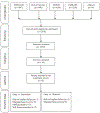Outcome of early dental implant placement versus other dental implant placement protocols: A systematic review and meta-analysis
- PMID: 30395355
- PMCID: PMC6500770
- DOI: 10.1002/JPER.18-0338
Outcome of early dental implant placement versus other dental implant placement protocols: A systematic review and meta-analysis
Abstract
Background: The aim of this systematic review and meta-analysis was to compare the clinical efficacy of the early dental implant placement protocol with immediate and delayed dental implant placement protocols.
Methods: An electronic and manual search of literature was made to identify clinical studies comparing early implant placement with immediate or delayed placement. Data from the included studies were pooled and quantitative analyses were performed for the implant outcomes reported as the number of failed implants (primary outcome variable) and for changes in peri-implant marginal bone level, peri-implant probing depth, and peri-implant soft tissue level (secondary outcome variables).
Results: Twelve studies met the inclusion criteria. Significant difference in risk of implant failure was found neither between the early and immediate placement protocols (risk difference = -0.018; 95% confidence interval [CI] = -0.06, 0.025; P = 0.416) nor between early and delayed placement protocols (risk difference = -0.008; 95% CI = -0.044, 0.028; P = 0.670). Pooled data of changes in peri-implant marginal bone level demonstrated significantly less marginal bone loss for implants placed using the early placement protocol compared with those placed in fresh extraction sockets (P = 0.001; weighted mean difference = -0.14 mm; 95% CI = -0.22, -0.05). No significant differences were found between the protocols for the other variables.
Conclusions: The available evidence supports the clinical efficacy of the early implant placement protocol. Present findings indicate that the early implant placement protocol results in implant outcomes similar to immediate and delayed placement protocols and a superior stability of peri-implant hard tissue compared with immediate implant placement.
Keywords: clinical protocols; dental implantation/methods; dental implants; meta-analysis; time factors; tooth extraction; tooth socket/surgery.
© 2018 American Academy of Periodontology.
Conflict of interest statement
DISCLOSURES
All authors have no conflict of interest.
Figures







References
-
- De Boever AL, Quirynen M, Coucke W, Theuniers G, De Boever JA. Clinical and radiographic study of implant treatment outcome in periodontally susceptible and non-susceptible patients: a prospective long-term study. Clin Oral Implants Res 2009;20:1341–1350. - PubMed
-
- Brnemark PI. Introduction to osseointegration In: Brnemark PI, Zarb GA, Albrektsson T, Rosen HM. Tissue-integrated prostheses: osseointegration in clinical dentistry. Chicago: Quintessence Publishing Company, Inc; 1985:11–76.
-
- Adell R, Lekholm U, Rockler B, Branemark PI. A 15-year study of osseointegrated implants in the treatment of the edentulous jaw. Int J Oral Surg 1981;10:387–416. - PubMed
-
- Araujo MG, Sukekava F, Wennstrom JL, Lindhe J. Ridge alterations following implant placement in fresh extraction sockets: an experimental study in the dog. J Clin Periodontol 2005;32:645–652. - PubMed
Publication types
MeSH terms
Substances
Grants and funding
LinkOut - more resources
Full Text Sources
Miscellaneous

